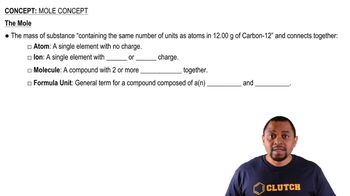Write the correct symbol, with both superscript and subscript, for each of the following. Use the list of elements in the front inside cover as needed: (a) the isotope of platinum that contains 118 neutrons
Ch.2 - Atoms, Molecules, and Ions
Chapter 2, Problem 32
Without doing any detailed calculations (but using a periodic table to give atomic weights), rank the following samples in order of increasing numbers of atoms: 0.2 mol PCl5 molecules, 80 g Fe2O3, 3.0 3 1023 CO molecules.
 Verified step by step guidance
Verified step by step guidance1
Step 1: Determine the number of atoms in 0.2 mol of PCl_5.
Step 2: Calculate the molar mass of Fe_2O_3 using the periodic table and determine the number of moles in 80 g of Fe_2O_3.
Step 3: Calculate the number of atoms in the moles of Fe_2O_3 obtained in Step 2.
Step 4: Determine the number of atoms in 3.0 \times 10^{23} CO molecules.
Step 5: Compare the total number of atoms from each sample to rank them in order of increasing number of atoms.

Verified video answer for a similar problem:
This video solution was recommended by our tutors as helpful for the problem above.
Video duration:
2mWas this helpful?
Key Concepts
Here are the essential concepts you must grasp in order to answer the question correctly.
Mole Concept
The mole is a fundamental unit in chemistry that quantifies the amount of substance. One mole contains approximately 6.022 x 10^23 entities, such as atoms or molecules. Understanding the mole concept allows for the conversion between the number of moles and the number of particles, which is essential for comparing different samples in terms of their atomic or molecular counts.
Recommended video:
Guided course

Mole Concept
Molar Mass
Molar mass is the mass of one mole of a substance, typically expressed in grams per mole (g/mol). It is calculated by summing the atomic weights of all atoms in a molecule. Knowing the molar mass of compounds like PCl5 and Fe2O3 is crucial for determining the number of moles present in a given mass, which directly influences the number of atoms in the sample.
Recommended video:
Guided course

Molar Mass Concept
Stoichiometry
Stoichiometry is the area of chemistry that deals with the relationships between the quantities of reactants and products in chemical reactions. It allows chemists to calculate the amounts of substances involved in reactions based on balanced chemical equations. In this context, stoichiometry helps in determining the number of atoms in different samples by relating moles to the number of atoms through the use of coefficients and molar ratios.
Recommended video:
Guided course

Stoichiometry Concept
Related Practice
Textbook Question
3
views
Textbook Question
Write the correct symbol, with both superscript and subscript, for each of the following. Use the list of elements in the front inside cover as needed: (b) the isotope of krypton with mass number 84 (c) the isotope of rhenium with mass number 187
3
views
Textbook Question
Write the correct symbol, with both superscript and subscript, for each of the following. Use the list of elements in the front inside cover as needed: (d) the isotope of magnesium that has an equal number of protons and neutrons.
3
views
Textbook Question
(a) What isotope is used as the standard in establishing the atomic mass scale?
6
views
Textbook Question
(b) The atomic weight of boron is reported as 10.81, yet no atom of boron has the mass of 10.81 u. Explain.
Textbook Question
(a) What is the mass in u of a carbon-12 atom?
